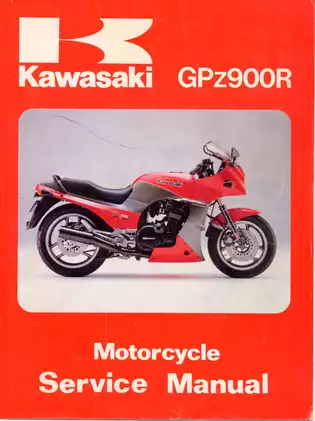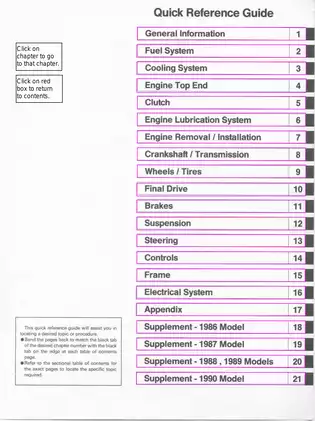Genuine Kawasaki GPz900R manual, 1984-96 edition
Product Gallery

Sample pages from the Genuine Kawasaki GPz900R manual, 1984-96 edition manual


Purchase Information
1984-1996 Kawasaki GPz900R motorcycle service manual - Technical Specifications
- Document Number / Seller:
- 26236 / Brian Wright
- File Size:
- 22.65 MB
- File Type:
- ZIP
- Language:
- English
- Printable:
- Yes
- Estimated Download Time:
- 0.46 Minutes
- Delivery Format:
- Digital (PDF) - Instant Access
- Category:
- Motorcycle
- Brand:
- Kawasaki
- Reviewed and Approved:
- May 26, 2025
Kawasaki Models and Parts Covered in this Motorcycle Manual
- GPz900R
- GPZ 900 / Kawasaki Motorcycle & Engine Company
Production/model years: 1984, 1985, 1986, 1987, 1988, 1989, 1990
Complete Manual Information
Table of Contents:
General Information
- Service Information
- Model Identification
- Specifications
Fuel System
- Carburetion
- Fuel Tank and Pump
- Fuel Filter
Cooling System
- Radiator
- Water Pump
- Hoses and Connections
Engine Top End
- Cylinder Head
- Valve Adjustment
- Camshafts
Clutch
- Clutch Assembly
- Clutch Operation
Engine Lubrication System
- Oil Pump
- Oil Pan
- Pressure Relief Valve
Engine Removal/Installation
- Procedures for Removal
- Installation Guide
Crankshaft/Transmission
- Crankshaft Maintenance
- Transmission Gears
Wheels/Tires
- Wheel Alignment
- Tire Replacement
- Balance
Final Drive
- Chain Adjustment
- Sprockets
Brakes
- Brake Pad Replacement
- Brake Fluid Change
Suspension
- Fork Rebuild
- Shock Absorbers
Steering
- Handlebar Alignment
- Steering Head Adjustments
Controls
- Throttle Adjustment
- Switches
Frame
- Inspection
- Repair
Electrical System
- Wiring Diagrams
- Battery Service
- Ignition System
Appendix
- Special Tools
- Torque Specifications
Supplements for Specific Models
- 1986 Model
- 1987 Model
- 1988 and 1989 Models
- 1990 Model
The price of this manual, handbooks and repair guides are not set by our marketplace, but by the seller of the manuals himself,
Download Instructions for Kawasaki Motorcycle Manual
Frequently Asked Questions - Kawasaki Motorcycle Manual
What does this Kawasaki manual cover?
This comprehensive service manual covers detailed repair procedures, maintenance schedules, troubleshooting guides, and technical specifications for Genuine Kawasaki GPz900R manual, 1984-96 edition. It includes information for the following models: - GPz900R - GPZ 900 / Kawasaki Motorcycle & Engine Company Production/model years: 1984, 1985, 1986, 1987, 1988, 1989, 1990.
Is this manual suitable for beginners?
Yes, this Kawasaki manual is designed for both professional technicians and DIY enthusiasts. It includes step-by-step procedures with clear illustrations and safety guidelines for Motorcycle maintenance and repair.
What file format will I receive?
You will receive this manual as a ZIP file (22.65 MB), which is compatible with all devices. The manual is fully searchable and printable for your convenience.
How quickly can I access the manual after purchase?
You'll receive instant access to your Kawasaki Motorcycle manual immediately after payment completion. The download link is valid for 3 days, with lifetime re-download guarantee.
Are engine specifications included?
This motorcycle service manual includes detailed engine specifications, valve clearances, torque settings, and performance data specific to your Kawasaki model.
Can I print specific sections of the manual?
Absolutely! This digital manual allows you to print any section you need, from individual pages to complete chapters, making it perfect for workshop use.
Customer Reviews and Feedback
Read what our customers say about this Kawasaki Motorcycle manual and share your own experience.
Add Comment
This policy contains information about your privacy. By posting, you are declaring that you understand this policy:
- Your name, rating, website address, town, country, state and comment will be publicly displayed if entered.
- Aside from the data entered into these form fields, other stored data about your comment will include:
- Your IP address (not displayed)
- The time/date of your submission (displayed)
- Your email address will not be shared. It is collected for only two reasons:
- Administrative purposes, should a need to contact you arise.
- To inform you of new comments, should you subscribe to receive notifications.
- A cookie may be set on your computer. This is used to remember your inputs. It will expire by itself.
This policy is subject to change at any time and without notice.
These terms and conditions contain rules about posting comments. By submitting a comment, you are declaring that you agree with these rules:
- Although the administrator will attempt to moderate comments, it is impossible for every comment to have been moderated at any given time.
- You acknowledge that all comments express the views and opinions of the original author and not those of the administrator.
- You agree not to post any material which is knowingly false, obscene, hateful, threatening, harassing or invasive of a person's privacy.
- The administrator has the right to edit, move or remove any comment for any reason and without notice.
Failure to comply with these rules may result in being banned from submitting further comments.
These terms and conditions are subject to change at any time and without notice.
Comments (2)